| Area | Sacramento R. |
| Topic | Tour: Upper Mainstem Sacramento Photos |
The completion of Shasta Dam blocked access to hundreds of miles of spawning habitat for salmon and steelhead in the upper Sacramento, Pitt and McCloud Rivers. It blocked access entirely for winter run chinook salmon which spawned far upstream. Photo courtesy of the California Department of Fish and Game.
Snow melt and melting glaciers kept flows in the McCloud and upper Sacramento Rivers cold during spring and summer which helped maintain optimal holding, spawning and egg incubation conditions for winter run chinook salmon. Mount Shasta is at the center of the photo above with Castle Crags in the foreground. The McCloud watershed is visible to the right of Mount. Shasta while the upper Sacramento flows near Back Butte at left. Both tributaries harbored winter run chinook prior to 1942. Photo courtesy of the California Department of Fish and Game.
The McCloud River above Shasta Reservoir is now a prime trout fishery for native rainbows and brown trout which migrate up out of Shasta Lake in fall. Bull trout were once present in the upper McCloud River but are thought to have gone extinct. It is possible that they relied on salmon carcasses, eggs and fry as a food base. Photo by Pat Higgins.
The upper Sacramento River is depicted here and once served as habitat for spring run and winter run chinook. Today it is a prime trout fishery but access to salmon is blocked by Shasta Dam. Photo courtesy of the California Department of Fish and Game.
The Red Bluff Diversion Dam provides an excellent place to monitor migration of salmon and steelhead up the Sacramento River. However, the diversion caused major problems with migration of all races of chinook salmon. At high flows, winter chinook were having problems finding fish ladders. If winter chinook spawned in downstream areas, water temperatures later in the summer were lethal. For more information, see Black (1998) in KRIS Bibliography.
The level of Shasta Lake can vary depending on the time of year and rainfall in recent years. This 1994 photo shows the reservoir at a very low level. This formerly posed problems as warm water from the surface of the lake was drawn into penstocks for Shasta Dam. The resulting warm water flows below in the Sacramento River posed a threat to survival of winter run chinook. Intakes were remodeled in 1995 and cool waters can now be released from depths even when lake levels are low.
This photo shows the McCloud River above Shasta Reservoir. Formerly habitat for spring and winter chinook salmon prior to the construction of Shasta Dam, the McCloud is now considered a trophy trout fishery. Photo courtesy of the California Department of Fish and Game.
 Click on image to enlarge (35K).
Click on image to enlarge (35K).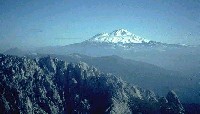 Click on image to enlarge (18K).
Click on image to enlarge (18K).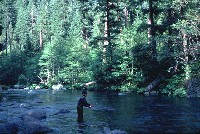 Click on image to enlarge (102K).
Click on image to enlarge (102K).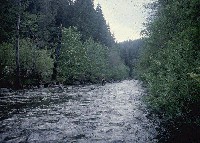 Click on image to enlarge (95K).
Click on image to enlarge (95K).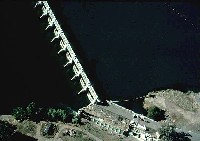 Click on image to enlarge (24K).
Click on image to enlarge (24K).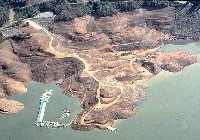 Click on image to enlarge (39K).
Click on image to enlarge (39K).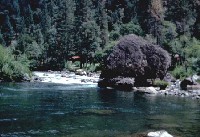 Click on image to enlarge (29K).
Click on image to enlarge (29K).
To view additional information (data source, aquisition date etc.) about this page, click Metadata
| www.krisweb.com |
